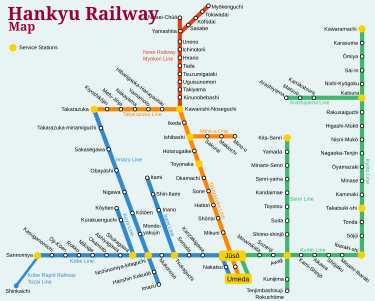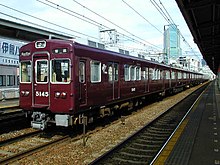Hankyu
This articleneeds additional citations forverification.(September 2015) |
 | |
 Six-track section near Umeda terminal; Nakatsu Station in the center | |
| Overview | |
|---|---|
| Parent company | Hankyu Hanshin Holdings(Hankyu Hanshin Toho Group) |
| Headquarters | Osaka,Japan |
| Locale | Kansai region,Japan |
| Dates of operation | 1910 (established in 1907)– |
| Technical | |
| Track gauge | 1,435 mm(4 ft8+1⁄2in) |
| Length | 138.4 km (86.0 mi) |
| Other | |
| Website | http://www.hankyu.co.jp/global/en/ |
Hankyu Corporation(Phản cấp điện thiết chu thức hội xã,Hankyū Dentetsu kabushiki gaisha,lit. 'Hankyu Electric Railway Stock Company'),trading asHankyu Railway(Phản cấp điện thiết,Hankyū Dentetsu,lit. 'Hankyu Electric Railway'),is a Japaneseprivate railwaycompany that provides commuter and interurban service to the northernKansai regionand is one of the flagship properties ofHankyu Hanshin HoldingsInc., in turn part of theHankyu Hanshin Toho Group(which includesH2O RetailingCorporation andTohoCo., the creator ofGodzilla). The railway's main terminal is atUmeda Stationin Osaka. The signature color ofHankyucars ismaroon.[1]
The Hankyu network serves 1,950,000 people every weekday and offers several types of express service with no extra charge.
The head offices ofHankyu Hanshin Holdings,Inc. and Hankyu Corporation are at 1-16-1, Shibata,Kita-ku, Osaka;both companies' registered headquarters are at 1-1, Sakaemachi,Ikeda,Osaka Prefecture.
TheTakarazuka Revue,an all-female musical theatre performance company, is well known as a division of the Hankyu railway company; all of its members are employed by Hankyu.
History[edit]
Etymology[edit]
The nameHankyuis an abbreviation ofKeihanshin Kyūko(Kinh phản thần cấp hành).
Keihanshin(Kinh phản thần)refers to the area served by Hankyu trains, comprising the cities ofKyoto(Kinh đô),Osaka(Đại phản)andKobe(Thần hộ),along with the suburbs that connect them to each other.
Kyūko(Cấp hành)means "express train(s)".
Foundation[edit]


In 1907, the Minoo Arima Electric Tramway Company(Ki diện hữu mã điện khí quỹ đạo chu thức hội xã,Minoo Arima Denki Kidō Kabushiki-gaisha),a forerunner ofHankyu Hanshin Holdings,Inc., was established byIchizō Kobayashi(precisely, he was one of the "promoters" of the tramway). On 10 March 1910, Minoo Arima Tramway opened the rail lines from Umeda to Takarazuka (theTakarazuka Main Line) and from Ishibashi to Minoo (theMinoo Line). The tramway was popular due to Kobayashi's pioneering act to develop housing around stations along the line (a first in Japan), a forerunner totransit-oriented developments.
Expansion to Kobe[edit]
On February 4, 1918, Minoo Arima Tramway was renamed Hanshin Kyūkō Railway Company(Phản thần cấp hành điện thiết chu thức hội xã,Hanshin Kyūkō Dentetsu Kabushiki-gaisha,referred to as "Hankyū",Phản cấp).
On July 16, 1920, theKobe Main Linefrom Jūsō to Kobe (later, renamed Kamitsutsui) and the Itami Line from Tsukaguchi to Itami were opened.
On April 1, 1936, the Kobe Main Line was extended from Nishi-Nada (present-day Ōji-kōen) to the new terminal in Kobe (present-dayKobe-Sannomiya Station), and the Kobe Main Line from Nishi-Nada to Kamitsutsui was named the Kamitsutsui Line, which was abandoned on May 20, 1940.
In 1936, Hankyu established aprofessional baseballteam and in 1937 theNishinomiya Stadiumas the team's home field was completed nearNishinomiya-Kitaguchi Station.The Hankyu Braves (named in 1947) played until the 1988 season and became the predecessors of the present-dayOrix Buffaloes.
Merger and separation with Keihan[edit]
On October 1, 1943, under the order of the government, Hanshin Kyūkō andKeihan Electric Railwaywere merged, and renamed Keihanshin Kyūkō Railway Company(Kinh phản thần cấp hành điện thiết chu thức hội xã,Keihanshin Kyūkō Dentetsu Kabushiki-gaisha,referred to as "Keihanshin",Kinh phản thần).The merged lines included theKeihan Main Line,theUji Line,theShinkeihan Line(present-day Kyoto Main Line), theSenriyama Line(present-day Senri Line), the Jūsō Line (part of Kyoto Main Line), theArashiyama Line,theKeishin Lineand theIshiyama Sakamoto Line.TheKatano Linewas also added in 1945.
On December 1, 1949, the Keihan Main Line, the Katano Line, the Uji Line, the Keishin Line, and the Ishiyama-Sakamoto Line were split off to become part of the newly establishedKeihan Electric RailwayCo., Ltd. Although this revived the former Keihan Electric Railway, Keihan was now smaller than before the 1943 merger, because the Shinkeihan Line and its branches were not given up by Keihanshin. The present structure of the Hankyu network with the three main lines was fixed by this transaction. The abbreviation of Keihanshin Kyūkō Railway was changed from "Keihanshin" to "Hankyū".
Postwar development[edit]

On April 7, 1968, the Kobe Main Line started through service to theKobe Rapid Transit RailwayTozai Lineand theSanyo Electric RailwayMain Line.
On December 6, 1969, the Kyoto Main Line and the Senri Line started through service to theOsaka Municipal SubwaySakaisuji Line.In 1970, the Senri Line was one of access routes to theExpo '70held in Senri area.
On April 1, 1973, Keihanshin Kyūkō Railway Company assumed its current name.

On April 1, 2005, former Hankyu Corporation became a holding company and was renamedHankyu Holdings, Inc.(Phản cấp ホールディングス chu thức hội xã,Hankyū Hōrudhingusu Kabushiki-gaisha).The railway business was ceded to a subsidiary, now namedHankyu Corporation(before the restructuring, the new company which reused a dormant company founded on December 7, 1989, was called "Act Systems"(Chu thức hội xã アクトシステムズ)until March 28, 2004, then "Hankyū Dentetsu Bunkatsu Junbi K.K."(Phản cấp điện thiết phân cát chuẩn bị chu thức hội xã)from the next day).
On October 1, 2006, Hankyu Holdings became the wholly owning parent company ofHanshin Electric Railway Co., Ltd.and the holdings were renamedHankyu Hanshin Holdings,Inc..Hankyu's stock purchase of Hanshin shares was completed on June 20, 2006.[2]
Rail lines[edit]


Hankyu operates three main trunk lines, connecting Osaka withKobe,TakarazukaandKyotorespectively, and their branches.
- Kōbe Kōsoku Line(Thần hộ cao tốc tuyến) (Category-2:Kobe-sannomiya–Shinkaichi,Trains are operated between Kobe-sannomiya and Shinkaichi on the Kōbe Rapid Transit Railway Tōzai Line)
The three groups of the lines, the Kobe Lines, the Takarazuka Lines and the Kyoto Lines, can be further grouped into two, the Kobe-Takarazuka Lines and the Kyoto Lines from a historical reason. Hankyu has two groups of rolling stock, one for the Kobe-Takarazuka Lines and the other for the Kyoto Lines.
Former lines[edit]
Abandoned lines[edit]
- Kitano Line (Umeda – Kitano)
- Kamitsutsui Line (Nishi-Nada (Ōji-kōen) – Kamitsutsui)
Transferred lines[edit]
- Keihan Line
- Ōtsu Line
The Keihan and Ōtsu Lines were transferred toKeihan Electric RailwayCo., Ltd. which separated from Keihanshin Kyūkō (now Hankyu) on December 1, 1949.
Rolling stock[edit]




As of March 31, 2010[update],Hankyu had 1,319 cars for passenger service.[3]Standard cars have three pairs of doors per side and bench seating facing the center of the train (exceptions are noted below). TheKobe LineandTakarazuka Lineuse the same fleet.
Some former Hankyu trains, such as the2000 seriesand3100 series,have been transferred to theNose Electric Railway.
Kobe Line/Takarazuka Line[edit]
- 1000 series
- 3000 series
- 3100 series
- 5000 series
- 5100 series
- 6000 series
- 7000 series
- 8000 series(includes small number of transverse seating cars)
- 8200 series
- 9000 series
Kyoto Line[edit]
- 1300 series(from spring 2014)
- 2300 series
- 3300 series
- 5300 series
- 6300 series(two doors per side, transverse seating)
- 7300 series
- 8300 series
- 9300 series(transverse seating)
Fares[edit]
Single fare (adult) in Japanese Yen by travel distance is as follows. Fares for children (6–11 years old) are half the adult fare, rounded up to the nearest 10 yen.
| Distance(km) | Fare (JPY) | ||
|---|---|---|---|
| effective
October 1, 2019 |
effective April 1, 2014[4] | effective April 1, 1997 | |
| 1–4 km (0.62–2.49 mi) | 160 | 150 | 150 |
| 5–9 km (3.1–5.6 mi) | 190 | 190 | 180 |
| 10–14 km (6.2–8.7 mi) | 230 | 220 | 220 |
| 15–19 km (9.3–11.8 mi) | 270 | 270 | 260 |
| 20–26 km (12–16 mi) | 280 | 280 | 270 |
| 27–33 km (17–21 mi) | 320 | 320 | 310 |
| 34–42 km (21–26 mi) | 380 | 370 | 360 |
| 43–51 km (27–32 mi) | 400 | 400 | 390 |
| 52–60 km (32–37 mi) | 470 | 470 | 450 |
| 61–70 km (38–43 mi) | 530 | 530 | 510 |
| 71–76 km (44–47 mi) | 630 | 620 | 600 |
For fare collection, IC cards (PiTaPa,ICOCAand others) are accepted.
The fare rate was changed on April 1, 2014, to reflect the change in the rate ofconsumption taxfrom 5% to 8%, and again on October 1, 2019, from 8% to 10%.[4]
In popular culture[edit]
A 2-car Hankyu train was featured in the 1988 Japanese animated war dramaGrave of the Fireflies.[5]
One 2008 book by the Japanese writerHiro Arikawa,Hankyu Densha,occurs entirely on the Hankyu–Imazu line, in the north-west suburbs of Osaka, where various characters meet and interact in the trains and at the various stations of the line. It was made into a film in 2011, titledHankyu Railway: A 15-Minute Miracle.
The Hankyu 2000 is the locomotive of choice for Takumi Fujiwara, the main character in Densha de D, a parody ofInitial Dwhere the main characters race with trains instead of cars.
See also[edit]
References[edit]
- ^Hội xã khái yếu[Company Overview] (in Japanese). Osaka, Japan: Hankyu Corporation. 2002. Archived fromthe originalon March 16, 2014.RetrievedNov 9,2012.
- ^"UPDATE 2-Hankyu takes over fellow railway operator Hanshin".Reuters.2006-06-20.Retrieved2006-06-20.
- ^Hankyu Corporation Toshikōtsū-jigyō-honbu Gijutsu-bu.Xa lạng tổng thuyết[General information on rolling stock].The Railway Pictorial(in Japanese).837(August 2010 Extra): 50.
- ^abHankyu Corporation (March 4, 2014)."Tiêu phí thuế suất ・ địa phương tiêu phí thuế suất の dẫn き thượng げに bạn う thiết đạo lữ khách vận nhẫm の cải định について"(PDF).RetrievedJune 8,2014.
- ^http://my.opera.com/opera%20kanta/blog/2008/08/13/grave-of-the-fireflies-hankyu-train.2008-08-13. Retrieved 2010-12-25.
